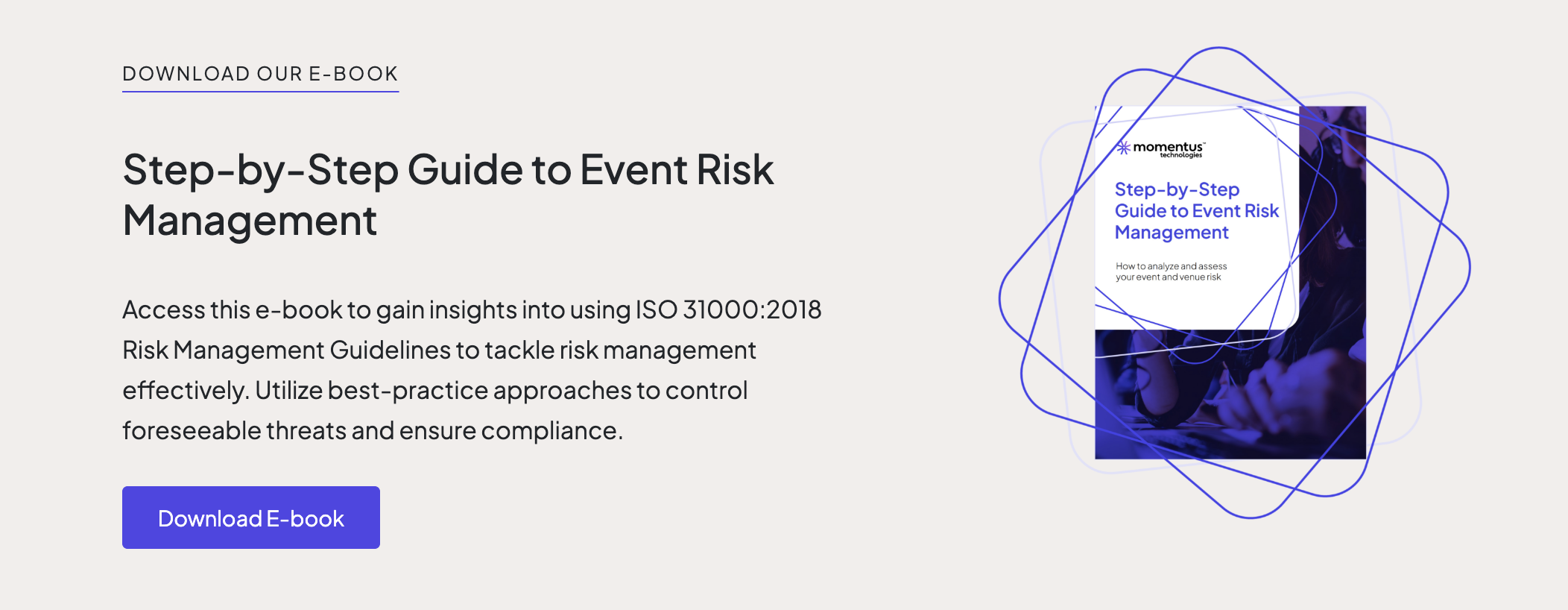What is Event Risk Management?

Event risk management is at the forefront for many venues and event departments. And for good reason — there are many things that have the potential to go wrong during live events.
Crowd crushes have become more frequent, from Astroworld to Itaewon Halloween and the crush at Cameroon. Gun-related violence, despite being lower than 2021, continues to be high across the U.S. Weather is also becoming an increasingly influential factor, whether you’re worried about rain impacting an outdoor event or winds knocking down temporary infrastructure to a venue. And safety and security are always a top concern for event planners when choosing a destination for temporary events, and for mitigating threats at permanent venues.
Too often, venues and organizations fail to prioritize the preventative elements of event risk management until after disaster strikes. While having response plans for emergencies is important, having a full understanding of operational elements to influence risk prevention will make for a more comprehensive resilience plan that can deliver safer and unforgettable events at your venue.
What is event risk management?
Event risk management sounds as if it pertains to all things safety, but this isn’t the case. The definition of “risk” is fairly encompassing and not limited to just safety-related incidents.
Risk management for events covers anything of significance that can go wrong at an event:
- Weather incidents (e.g., It rains on the day of your outdoor event.)
- Speaker-related events, like them not making it or arriving late.
- Power issues, such as a power outage.
- Safety-related risks, like crowd crushes, fire, etc.
- The serving of alcohol and whether it’s monitored.
The above list of risks is by no means exhaustive, as risks vary based on the type of event, the venue and the impact of the risk occurring.
Event risk management itself is the practice of assessing risks before they arise and coming up with a plan to mitigate each one through prevention and/or preparedness. Usually, a combination of these strategies is the most effective approach, particularly for more significant risks.
Effective risk management also requires a level of prioritization of risk by using a process called risk analysis. This helps establish the significance of each risk over one another and allows for better decision making, even with limited resources.
Tips for managing event risk management
Every event, venue and audience are different, making it difficult to fully prevent risks across the board. There are several steps you can take to ensure you’re keeping your audiences as safe as possible, while delivering a memorable event.
Run a risk assessment
The first step in any risk management plan is running a risk assessment. During an assessment, look at each upcoming event and consider the following:
- The venue: What unique risks come with the venue? Is it outdoors? Is it in a crowded, popular spot? Does the venue have backup power? What threats exist at this venue and are there places in particular that are vulnerable?
- Transportation: How will people get to the venue? If you’re providing transportation, is there a contingency plan in case the transportation falls through? Is the event location easy to access?
- Crowd control: Are there any concerns with access points for the crowd's entry, exit or circulation? Crowd crushes are increasingly common at music events, so it’s important to think about how the attendees are seated or standing. Is there plenty of room for people to get around, with easily accessible emergency exits?
- Weather: Will the weather impact this event? If it’s outdoors, do you have a way to cover the event space or a backup space your attendees can move to? Wind, temperature, rain and lightning are very important considerations, particularly for outdoor events.
- Staff: Staff plays a critical role in event risk management, as many operational responses require the structured response of staff and volunteers. Do you have enough staff or volunteers on-hand? Are there extra staff available if some people can’t make it? Are any of the staff qualified to provide specialized assistance for those that need it? Have they been adequately inducted and trained to operate in their role effectively?
Create a taskforce
With risks assessed, it’s time to assemble a team. Identify and involve relevant event risk management stakeholders and create a working group. Each stakeholder should own a certain risk or risk group and lead any necessary efforts in the mitigation of risk and in the event something goes wrong.
Typical stakeholders might include your internal events team, security specialists and third-party vendors assisting with the event, etc.
Each stakeholder should also help develop contingency plans, where applicable, for each risk.
Rate any identified event risk by likelihood and severity
Go through the list you created in the previous step and rank each event risk by severity and likelihood. Put items most likely to happen or those with the greatest severity or risk level near the top and prioritize them.
During this stage you should also assign stakeholders or owners for each risk or risk category. Think about which stakeholders are most relevant to the given event risk and then reach out to them about having ownership over that risk.
Develop contingency plans
Develop contingency plans for event risks based on their ranking in your list. Those most likely to occur or those with the greatest severity should take top priority.
The previously identified stakeholders should help develop contingency plans for each relevant risk, working with your events team to make sure there’s a reasonable backup plan in place.
For example, if a third-party caterer is providing food, they should be capable of delivering a backup plan that spells out what they’ll do if they’re out of a certain item, running late and so on.
Specifically with third-party vendors, it’s also a good idea to have a backup plan outside the vendor’s plan. While the vendor can and should provide a contingency plan for X, Y, Z, your team should have a backup plan in the event the vendor can’t make it. Is there a backup vendor on standby? Local business that’s capable of helping?
Note: It’s not always feasible to have a contingency plan for every single event risk. Mitigate what you can, especially those items near the top. For everything else, simply make sure your staff are aware of the risks and ready to help if something goes wrong. Falling back on insurance is a last, but important resort. Ensure each supplier carries appropriate insurance and that they can provide a Certificate of Currency to prove their coverage is in place.
Run trials of your contingency plans, if possible
While not always feasible, depending on what’s involved in the backup plan, it’s a good idea to run through trials with your contingency plans. This can be as simple as sitting down at the table with your stakeholders and walking through the plan, step-by-step, to see if there are any hangups or potential points of failure.
For example, say you want to run a trial of a weather contingency plan. Sit down with any relevant stakeholders and walk, step-by-step, through the process. It’s the day of the event and it’s raining. Now what? Who moves the event to a new location or makes sure covers are put up? What could go wrong during these processes?
Simplifying event risk management
Event risk management is critical to the long-term success of your venue or organization. One disaster is all it takes for people to lose trust in your business, or worse. With the right steps you can develop processes that help reduce the likelihood of risks coming to fruition, while still delivering great events.
Furthermore, the right event risk management software can make your processes even more fruitful.
Risk and uncertainty are becoming an increasingly important consideration for venue and event planners. Between the increasing frequency of crazy weather patterns and the amplification of reputational risks via social media, it's never been more important to get a handle on and prioritize our efforts toward risk. Get out in front of the risk, and don't wait for it to come before you respond.
Momentus Risk Manager enables you to streamline risk management with several features:
- Risk screening questionnaire that generates a risk score.
- Risk analysis and evaluation tools that compare risks based on score.
- Risk mitigation measure tool that simplifies selecting controls.
- Real-time updates from stakeholders on risks and related activities.
- End-to-end risk monitoring that covers everything from planning to post-events.
Take some of the stress out of event risk management with Moment Risk Manager. Schedule a free demo and see for yourself today.

